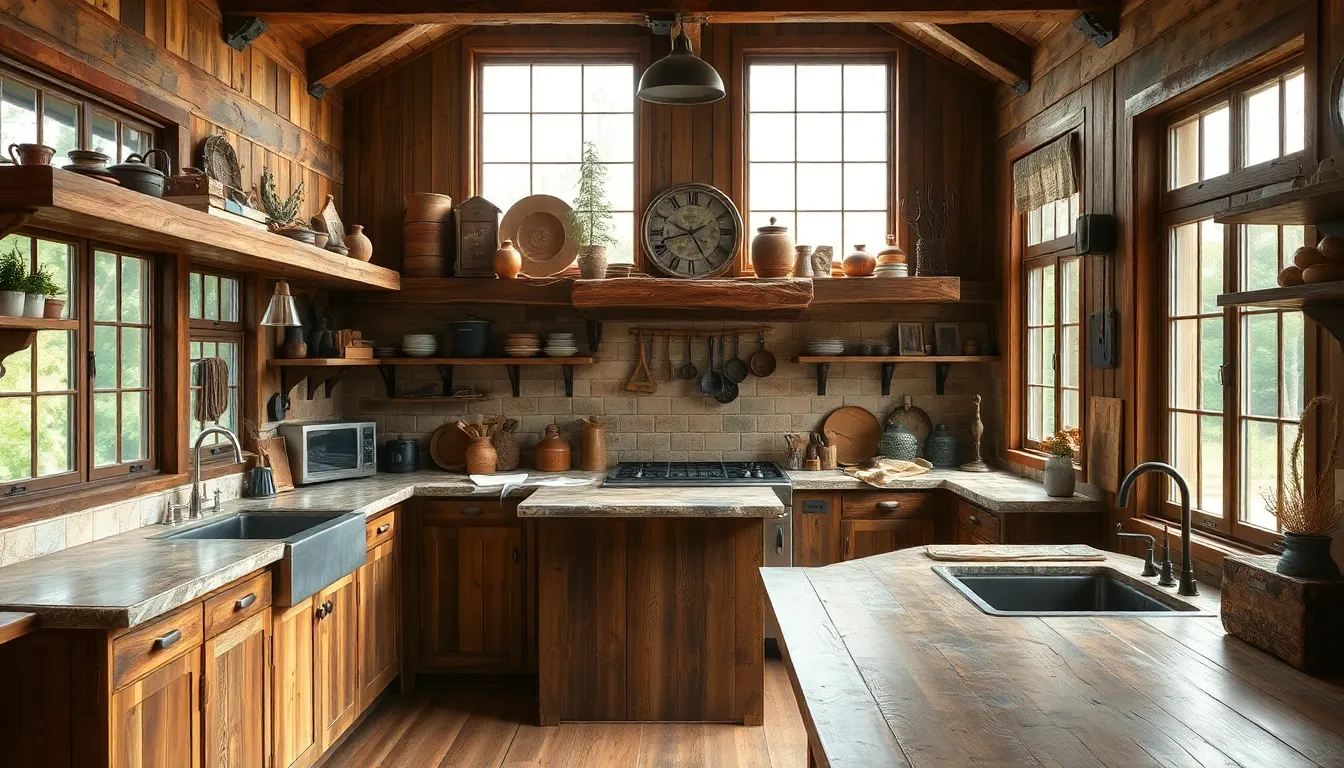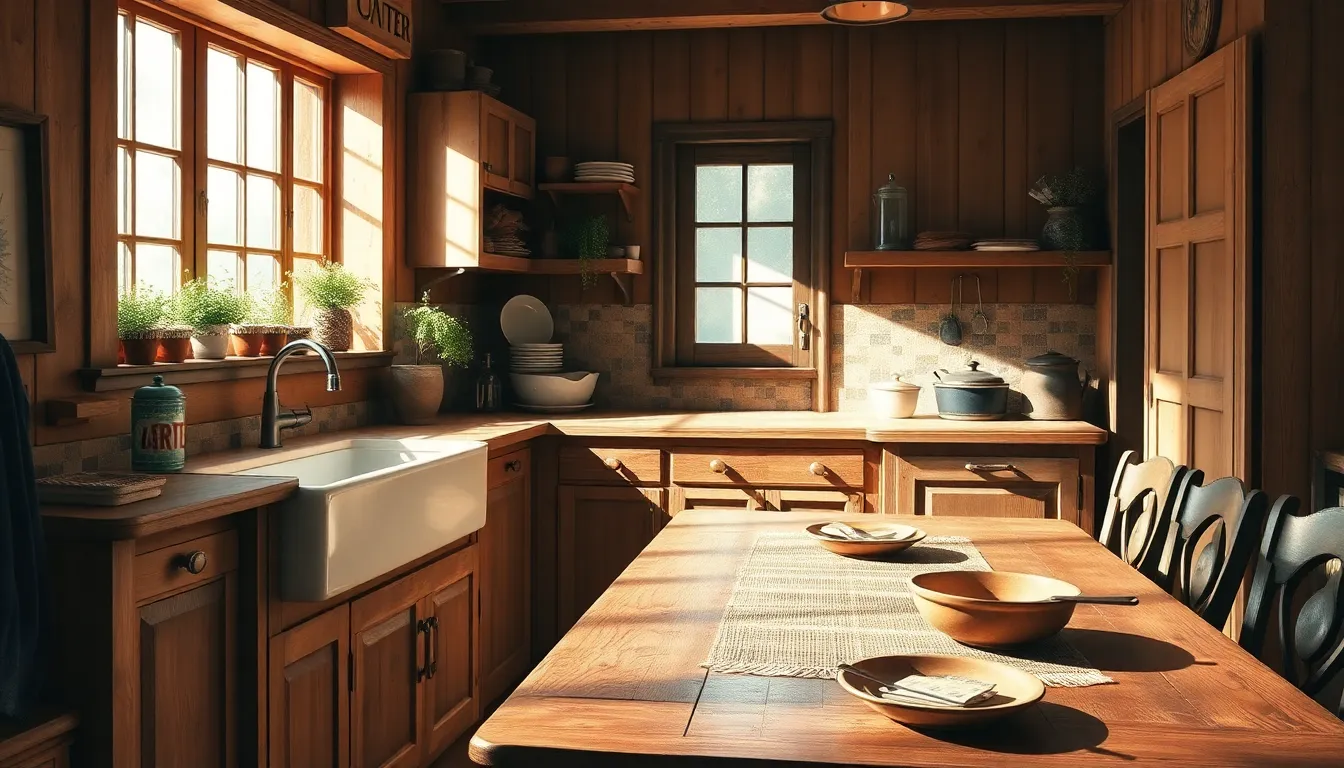Imagine stepping into a kitchen that feels like a cozy cabin in the woods, where the aroma of freshly baked bread fills the air and every corner whispers tales of family gatherings. Rustic kitchen design captures that warm, inviting essence, blending charm with functionality. It’s not just about wood beams and vintage pots; it’s a lifestyle choice that brings the outdoors in, making every meal feel like a special occasion.
Table of Contents
ToggleOverview of Rustic Kitchen Design
Rustic kitchen design draws inspiration from nature and traditional craftsmanship. Characteristics include natural materials, earthy colors, and vintage elements. Warm woods, stone, and metal accents create a cozy atmosphere. The overall aesthetic often features reclaimed wood cabinets and open shelving that showcase charming dishware.
Functionality plays a key role in rustic kitchens. Generous counter space, practical layouts, and durable appliances enhance usability. Large farmhouse sinks and sturdy kitchen islands frequently serve as focal points within the design. Each element complements the rustic theme while ensuring the kitchen remains efficient and lively.
Lighting choices further contribute to the ambiance. Soft, warm light fixtures like wrought iron chandeliers or pendant lights add character. Natural light streaming through large windows enhances the connection to the outdoors, bringing a sense of serenity.
Textiles help soften the hard surfaces found in rustic designs. Fabric elements, such as plaid curtains or woven table runners, introduce warmth and texture. Mixing patterns and colors alongside natural materials creates visual interest.
Accessories and decorations play an integral role in finishing the look. Hand-crafted items, vintage utensils, and nature-inspired artwork personalize the space. These touches reflect individual style and bring a sense of history into the kitchen.
The appeal of rustic kitchen design resides in its welcoming atmosphere. Spaces encourage family interaction and gatherings, making meals more special. This design style fosters a connection to the past while accommodating modern needs, creating a balanced, inviting environment.
Key Elements of Rustic Kitchen Design

Rustic kitchen design combines natural aesthetics with functional elements. Key aspects include materials, color palettes, and more.
Materials Used
Natural materials define rustic kitchens. Wood remains a prominent choice, ranging from reclaimed beams to distressed cabinets. Stone surfaces, like countertops and backsplashes, add earthy texture. Metal accents, including wrought iron and copper, enhance durability and charm. These elements create a cohesive look reminiscent of traditional craftsmanship. Choosing sustainable materials supports environmental values, aligning with this style’s connection to nature. Incorporating textures, such as wicker and linen, introduces warmth and character to the space.
Color Palettes
Color palettes in rustic kitchens reflect the outdoor landscape. Earthy tones, including browns, greens, and muted reds, dominate the scene. Warm neutrals provide a soothing backdrop, allowing wood and stone features to shine. Accent colors can highlight vintage decor or handmade items, adding personality. Consider using weathered paint finishes on cabinets to achieve a timeless feel. Incorporating natural light supports an open and airy atmosphere. This harmonious blend of colors fosters a welcoming vibe, perfect for family gatherings and everyday meals.
Popular Rustic Kitchen Styles
Rustic kitchens come in various styles that blend aesthetics and functionality. Each style offers unique elements and charm, enhancing the overall warm ambiance.
Farmhouse Style
Farmhouse style thrives on simplicity and warmth. It features large, open spaces that encourage family interaction. Reclaimed wood beams and shiplap walls add character and authenticity. Farmhouse sinks, often deep and wide, serve as practical focal points. Bright white cabinets combined with natural wood tones create a classic contrast. Accessories like vintage aprons and mason jar decorations bring a homespun touch. Soft, inviting color palettes, including muted greens and warm whites, contribute to the cozy feel. This style emphasizes a nostalgic connection to rural living.
Industrial Rustic
Industrial rustic combines raw, unfinished elements with cozy details. Exposed brick walls and steel beams create an urban yet warm environment. Open shelving displays vintage dishware, enhancing the industrial aesthetic. Concrete countertops provide durability and a modern touch. Metal accents, such as pendant lights and bar stools, complement the rustic elements. Dark wood cabinetry contrasts with lighter accents, creating visual interest. The color scheme often integrates grays and browns for a balanced look. This style merges functionality with a distinct character that invites conversation.
Incorporating Modern Features
Integrating contemporary elements into rustic kitchen design enhances functionality while preserving charm. This approach creates a balanced atmosphere that resonates with both innovative and traditional aesthetics.
Blending Old and New
Mixing vintage and modern pieces cultivates a unique kitchen space. Reclaimed wood beams complement stainless steel appliances perfectly. Antique furniture harmonizes well with sleek, minimalistic cabinetry. A rustic wooden table becomes a focal point alongside chic dining chairs. Use of both eras elevates the kitchen’s character while maintaining warmth and comfort.
Technology in Rustic Kitchens
Advanced appliances significantly enhance efficiency in rustic kitchens. Smart refrigerators offer convenient features while blending with natural designs. Induction cooktops cater to both performance and style, fitting seamlessly among traditional elements. Under-cabinet lighting provides practical illumination, making the kitchen functional and inviting. Integrating technology ensures that rustic charm pairs flawlessly with modern convenience.
Rustic kitchen design offers a unique blend of warmth and functionality that transforms any cooking space into a welcoming retreat. Its emphasis on natural materials and earthy tones creates an inviting atmosphere perfect for family gatherings. By incorporating vintage elements and modern conveniences, this style fosters a harmonious balance between charm and practicality.
Whether one leans towards a traditional farmhouse aesthetic or an industrial twist, rustic kitchens celebrate the beauty of craftsmanship and sustainability. The result is not just a kitchen but a lifestyle choice that enhances daily living while honoring the past. Embracing rustic design can truly elevate the heart of any home.



